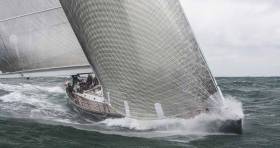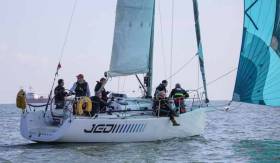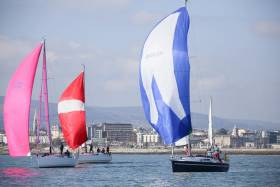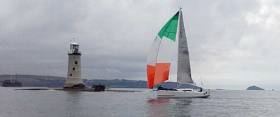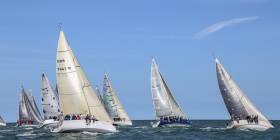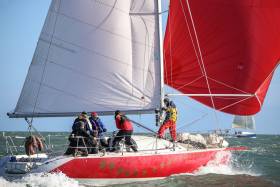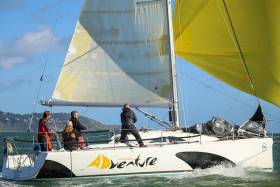Displaying items by tag: ISORA
Time was when the Dun Laoghaire to Dingle Race was promoted as a handy way to position your little old cruiser in West Kerry to be nicely placed to make her way in gentle hops back to her home port on the south or east coast, ambling in leisurely stages along one of the finest cruising grounds in the world writes W M Nixon.
It was envisaged primarily as a sort of enlarged club race, the club setting the tone being the National Yacht Club in Dun Laoghaire. There, enthusiastic members and Dingle race plotters Martin Crotty, Peter Cullen and Brian Barry added a further attraction when promoting the first race, as it drew nearer in 1993, by suggesting that real dyed-in-the wool cruising types might find the race of interest if they were thinking of continuing with a clockwise cruise on round Ireland.
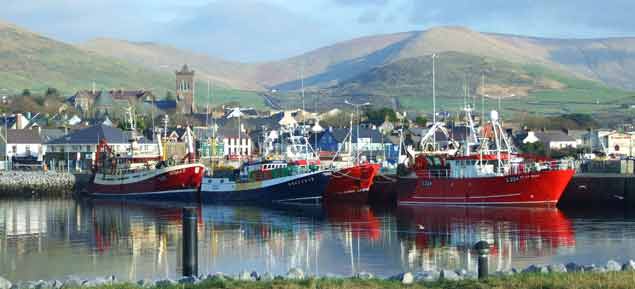 Dingle Harbour makes for an attractive destination...
Dingle Harbour makes for an attractive destination...
 …while its marina is enticing for cruisers and racers alike
…while its marina is enticing for cruisers and racers alike
Lovely idea. But so far as I know – though it’s very much hoped that I’ll be rapidly informed otherwise – it is this goggle-eyed wordsmith focused on his ancient computer screen who is still the only cruiser-racer skipper who has completed the Dun Laoghaire to Dingle Race, and then cruised on round Ireland.
We did it in handy stages, leaving the boat in Dingle for ten days after the race was completed to return home to the word-production coalface, then going on to leave her on a mooring we’d laid at Arbear at the head of Clifden Bay after we’d cruised the Aran Islands and Connemara in detail, followed by another return home for the manufacture of merchandisable verbiage. Then the third stage was home to Howth round the top, with Donegal doing its best to rival Kerry for dramatic scenery.
However, that was all a very long time ago. In fact, it was so long ago it was the first time I’d sailed with a proper pair of Dubarry Shamrock Goretex boots. I’d previously had an experimental leaky pair from a different manufacturer with which I’d persisted for years, so I can still remember the sheer joy of dry warm feet whatever the weather after the genuine Dubarrys had been deployed.
But enough of such ramblings - even if it does serve to remind us of the way the Dun Laoghaire to Dingle Race has become a much-loved part of our sailing world. And as for the reason for people not cruising on round Ireland when being in Dingle leaves them so handily placed for continuing the circuit - the answer is simple. The fact is that the course of almost 300 miles has taken them as swiftly as possible past some of the most glorious cruising places in Ireland, and the only way the skipper can keep his shipmates plugging on is by swearing on all that is holy that they’ll cruise gently back the same way in a much more civilised style.
In such circumstances, you’re whistling against the wind in trying to sell the coast of Connacht as the more interesting way to get home. Yet from an early stage, even the notion of the Dingle dash as having a strong cruising orientation hasn’t really held up for a significant part of the entry. People go into it with every intention of winning, and the talk of conveniently positioning the boat for a spot of cruising in Kerry and West Cork has only been smoke and mirrors.
![]() The Yellowbrick record of the Dun Laoghaire-Dingle Race in 2015. Sometimes the fleet has been even more widely spread than this
The Yellowbrick record of the Dun Laoghaire-Dingle Race in 2015. Sometimes the fleet has been even more widely spread than this
The pace was set from the off in 1993, when the winner was Richard Burrows’ Sigma 36 Black Pepper. In subsequent years, she was cruised to Greenland and other Godforsaken spots in the ownership of fellow Malahide sailor Peter Killen, so Black Pepper has a boat history which must make her the best-used Sigma 36 ever. Certainly for the Dingle dash of 1993, skipper Burrows shipped aboard the formidable talents of Peter Wilson and Robert Dix as the main occupants of the driving seat, and Black Pepper had a wellnigh perfect race.
That said, at the riotous prize-giving afterwards – the Dingle prize-giving is always riotous, just relax and enjoy it – Black Pepper’s skipper gave a wildly funny speech which he rounded out by presenting Robert Dix with the Golden Blanket Award. As to what was meant by that I haven’t a clue, so you’ll have to ask Dixie himself. But as he has been winning major awards of every kind since 1970 when he became the youngest ever Helmsmans Champion, the Golden Blanket goes well in his trophy cabinet.
With the first race off to such a humdinger inauguration, the vision of the founders had been justified. Well, perhaps “vision” is overstating it. At this week’s launching of the 2017 staging, which will be on June 14th, longtime organiser Martin Crotty revealed that the idea of the Dingle Race came about almost by misadventure.
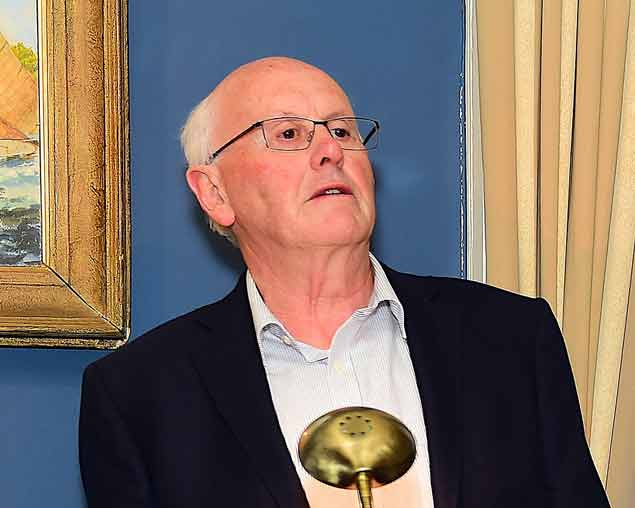 The founding Dingle Race organiser Martin Crotty reminiscing about the early days in 1993 at this week’s reception in the National Yacht Club. Photo Michael Chester
The founding Dingle Race organiser Martin Crotty reminiscing about the early days in 1993 at this week’s reception in the National Yacht Club. Photo Michael Chester

He and fellow owner Peter Cullen had been doing the 1992 Round Ireland Race with their hefty Sigma 41 Koala, and in slugging up the west coast into a particularly unpleasant northerly (I remember that one too), their mainsail went into several pieces on the latitude of Loop Head, so they retired and ran back to Dingle, a place they didn’t know at all.
They got to know it very well indeed over the next day or two, and the hospitality the little West Kerry port meted out to them – with the Dingle Skellig Hotel more or less providing open house – soon got them thinking that a race there rather than sailing all the way round the Emerald Isle would be an interesting alternative in the years when the biennial Round Ireland Race from Wicklow was not being staged.
Such ideas seem marvellous over a pint or three as midnight draws on, then fade from the memory. But there was some special chemistry already at work between the can-do Dun Laoghaire sailors and the maritime-minded folk of Dingle. Perhaps it’s because both ports think they’re the hub of the universe…… Whatever the secret ingredient, by 1993 in Dingle Harbour, Master Brian Farrell was ready to welcome the fleet, a new marina was in the making, and Dingle was on the cusp of an entirely new era.
 Dingle in the far west of Kerry has formed strong links with Dun Laoghaire in Dublin Bay, yet the two places could not be more different.
Dingle in the far west of Kerry has formed strong links with Dun Laoghaire in Dublin Bay, yet the two places could not be more different.
As for the Dun Laoghaire to Dingle Race, we knew it was fully part of the scheme of things by 1995, as Denis Doyle turned up to compete with Moonduster. Once that happens, you know your race has arrived, and “The Doyler and The Duster” were honoured participants for many years, encouraging some very substantial boats to subsequently take part, with new heights being reached in 2009 when Michael Cotter’s handsome 78ft Whisper brought a touch of global glamour and a new record, though she missed the magic 24 hours by 43 minutes and 45 seconds.
As each race succeeded its predecessor, a bonus emerged when it was acknowledged that the Dun Laoghaire to Dingle would count as a qualifier for the Fastnet Race, which would as usual be staged about eight weeks later. By this stage the race had so much going for it that it seemed impervious to setback, but like everything else in Irish life, it went through diminished times during the recessionary years.
 When “The Doyler and The Duster” (Denis Doyle and Moonduster) became involved from 1995 onwards, the Dun Laoghaire to Dingle race was made. This is a page from the August 199 Afloat magazine, with Moonduster much in evidence in the race report. The winner that year was Donal Morrissey’s GK34 Joggernaut from Galway, and in those days the start was in Dun Laoghaire Harbour.
When “The Doyler and The Duster” (Denis Doyle and Moonduster) became involved from 1995 onwards, the Dun Laoghaire to Dingle race was made. This is a page from the August 199 Afloat magazine, with Moonduster much in evidence in the race report. The winner that year was Donal Morrissey’s GK34 Joggernaut from Galway, and in those days the start was in Dun Laoghaire Harbour.
But then came 2015, and the numbers were back up, and then some. Having seen his pet project through times good and bad, Martin Crotty had indicated that this 12th Dun Laoghaire to Dingle Race would be the last he would personally administer, but already a strong successor was being briefed in the person of Adam Winkelmann. And in the 2015 race he had a vintage familiarisation to observe how it all worked, though as his mother Carmel was for many years one of the time-keepers, he started from a position of inside knowledge.
Over the years, the Dingle Skellig Hotel, which showed such generosity to the sea-battered crew of Koala way back in 1992 – leading to the inception of the race – has stayed on board as co-sponsor, and everyone’s longterm faith in the event was born out in 2015’s race, which was a classic. Before it, the atmosphere around the National Yacht Club was pure carnival, and while the start may have been slow, the winds soon filled in from the north and the fleet scampered down the east coast.
Out in front, the line honours battle was between Adrian Lee’s Cookson 50 Lee Overlay Partners from Dun Laoghaire and Anthony O’Leary’s Ker 40 Antix from Cork, and they went so well that for a while it looked like Antix might get the corrected time win. But holes in the wind at the Fastnet and beyond shook up the order, and by the finish it was glory day for J Boats, with the Shanahan family’s J/109 Ruth (NYC) winning by 20 minutes from her Pwllheli-based sister-ship Mojito (Peter Dunlop & Vicky Cox), the first foursome being very complete for the Johnstone brothers as the J/122 Aurelia was third and the J/109 Dear Prudence was fourth.
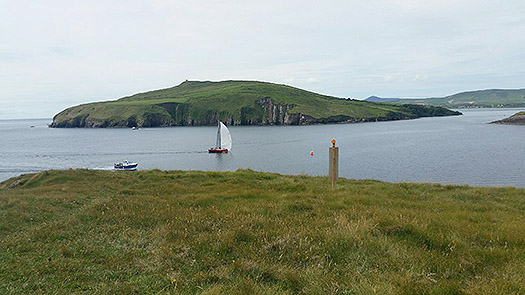 Anthony O’Leary’s Ker 40 Antix crossing the finish line at Dingle in 2015
Anthony O’Leary’s Ker 40 Antix crossing the finish line at Dingle in 2015
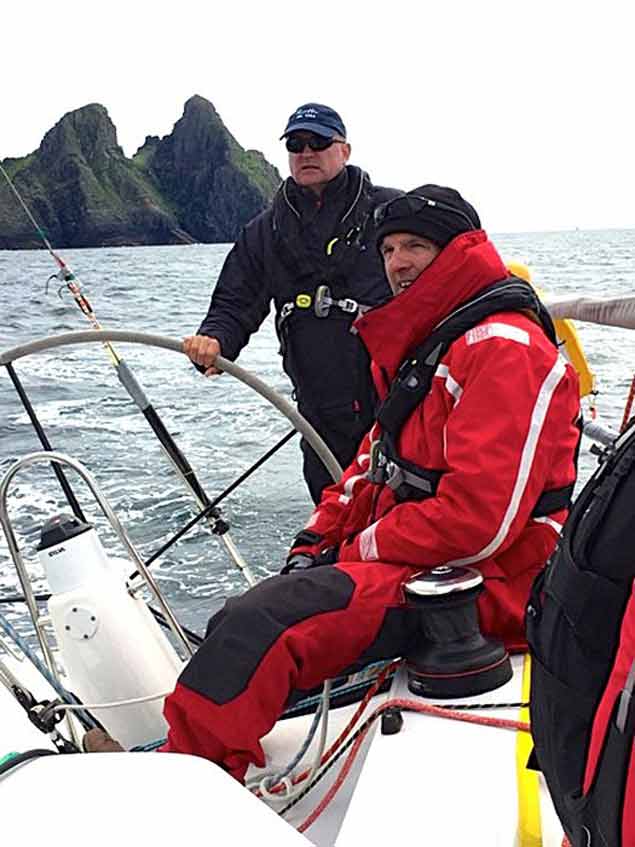 Overall 2015 winner Liam Shanahan at the helm of his J/109 Ruth with Skellig Michael put astern, and crewman Kevin Daly trimming the main for the final stage up Dingle Bay to the finish.
Overall 2015 winner Liam Shanahan at the helm of his J/109 Ruth with Skellig Michael put astern, and crewman Kevin Daly trimming the main for the final stage up Dingle Bay to the finish.
 After a rugged race, there’s nothing like an al fresco party at Dingle
After a rugged race, there’s nothing like an al fresco party at Dingle
But in a fascinating contest, almost every boat was having her day at one stage or another, and for those who were doing the race as a Fastnet qualifier, it came up trumps. Irish Offshore Sailing’s 36ft Jeanneau Desert Star may have only been in the middle of the fleet in the Dingle results, but her crew were on a learning curve and on top form by the time they did the Fastnet Race, so much so that they won overall in the 33-boat fleet making up the Sailing Schools Division, a well-earned dream result for skipper Ronan O Siochru.
So Martin Crotty handed over a prestigious event in really good order to Adam Winkelmann after all the D2D business was done and dusted in 2015, and this week’s launching reception in the National Yacht Club for what is now the Volvo Dun Laoghaire to Dingle Race was one of those gatherings which ticked so many boxes that we could get a month’s worth of Sailing on Saturdays out of it.
The heartwarming sense of continuity was palpable. Not only was Adam Winkelmann taking over the D2D from Martin Crotty, but in the host club, Ronan Beirne had been barely a wet week as the new Commodore in succession to Larry Power. To say that the speeches were in tune with the mood of the evening barely gets the flavour of it. It was a time for nostalgia, a time for relishing the present, and a time for keenly anticipating the future, with all aspects covered.
 Adam Winkelmann, chair of the Volvo Dun Laoghaire Dingle race Committee, reveals his hopes for 2017’s race and the races beyond. Photo: Michael Chester
Adam Winkelmann, chair of the Volvo Dun Laoghaire Dingle race Committee, reveals his hopes for 2017’s race and the races beyond. Photo: Michael Chester
It was Adam Winkelmann who summed it all up in a friendly presentation – he does it so painlessly that the word “speech” is way too pompous – effortlessly telling us about the new dynamic with the lineup with Volvo, the continued support from Dingle with the Dingle Skelligs Hotel joined by Crean Brewery – and the growing interest from the RORC with that club’s Janet Grosvenor – a very good friend to Irish offshore racing – planning to monitor the Volvo Dun Laoghaire to Dingle Race 2017 with a view to giving it greater recognition in the RORC’s 2019 programme.
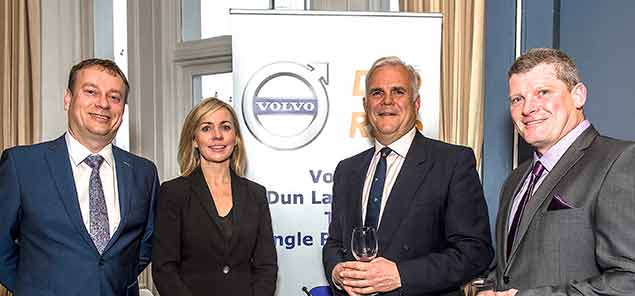 Graham Fitzgerald of the Dingle Skellig Hotel, Patricia Greene of Volvo Car Ireland, Adam Winkelmann, and Jerry O’Sullivan of Crean Brewery, Dingle. Photo Michael Chester
Graham Fitzgerald of the Dingle Skellig Hotel, Patricia Greene of Volvo Car Ireland, Adam Winkelmann, and Jerry O’Sullivan of Crean Brewery, Dingle. Photo Michael Chester
As it is, the 2017 race will start on the evening of Wednesday June 14th, which research among competitors has show is reckoned as the most user-friendly time for those fitting the race into work breaks, as it means you can definitely do a three day week, yet have every chance of making the clock-in at the workplace first thing Monday morning.
Thus the prize-giving will be on Saturday night, and it is being moved beck to the Dingle Skelligs’ sister establishment, Benners Hotel in the heart of town. As for the bigger picture, the timing also allows a useful gap before the Sovereigns Cup series starts at Kinsale on June 21sr, but while the start time will be tight for anyone who also plans to also do the ICRA Nationals at Crosshaven from Friday June 9th to Sunday June 11th, in times past we’d have reckoned that’s it a logistical challenge which is do-able, you just draw lots for the three guys who are going to take the boat to Dun Laoghaire as soon as the last race at Crosser is over.
As if that’s not enough of a challenge, Ric Morris has lately been airing a suggestion that it’s time to think seriously about an Irish National Offshore Championship based around the many events already in existence. He reckons that with the Round Ireland and the Dun Laoghaire to Dingle races alternating at the peak of this annual season-long series, we’d have an intriguing setup which has the potential to involve many boats – and he means many big time.
Certainly the imprimatur of the RORC on the Volvo Dun Laoghaire Dingle Race would give it turbo power, making it a serious points accumulator apart from being a superb race in its own right. Truly it has moved on a long way from being a handy little club-oriented event best used to position your boat in Ireland’s finest cruising ground. But we shouldn’t be surprised, when we remember that the Fastnet Race itself started in a very modest way in 1925. It was so shunned by the sailing establishment that it couldn’t get a starting line at Cowes, and had to be sent eastward out of the Solent from the start line of the Royal Victoria Yacht Club at Ryde.
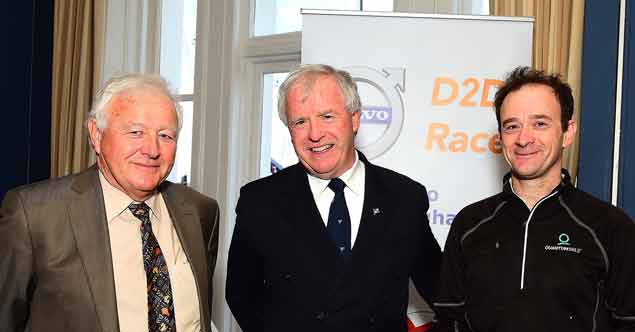 Brian Farrell, Harbour Master of Dingle when the Dun Laoghaire-Dingle race was inaugurated in 1993, Ronan Beirne the newly-elected Commodore of the National Yacht Club, and Yannick Lemonnier, who will be racing a Minitransat 650 to Dingle. Photo Michael Chester
Brian Farrell, Harbour Master of Dingle when the Dun Laoghaire-Dingle race was inaugurated in 1993, Ronan Beirne the newly-elected Commodore of the National Yacht Club, and Yannick Lemonnier, who will be racing a Minitransat 650 to Dingle. Photo Michael Chester
Presumably the RORC still sends the RVYC an annual Christmas card as a token of their appreciation of that display of faith way back in 1925, now that the hugely popular Fastnet Race is started from all the glory of the Royal Yacht Squadron line at Cowes.
And as for the Dun Laoghaire-Dingle Race in all its manifestations, while it has always been comfortably under the imprimatur of the National Yacht Club in Dun Laoghaire, the developing positive attitude towards sailing at official levels in Dun Laoghaire/Rathdown was underlined by the official presence at Tuesday’s gathering of Councillor Cormac Devlin, Cathaoirleach of Dun Laoghaire/Rathdown County Council.
But while the new turbo power of the Volvo Dun Laoghaire to Dingle Race was quietly in evidence at the party in the National YC this week, it was good to meet up with old friends from Dingle from the earliest days, particularly the former Harbour Master Brian Farrell whose enthusiasm for his job always went way beyond the call of duty.
There too were Brian Barry and Peter Cullen, both of whom did so much to put the show on the road and keep it there through times good and bad. But it was appropriate that also present was the one and only Yannick Lemonnier, who did the race in the two-handed division in 2015 (he was second to Howth’s Colm Buckley and Simon Knowles) but in 2017 will be doing it in a new special division which has been encouraged into the fray by the National’s Sailing Manager Olivier Prouveur.
Yes indeed – the Volvo Dun Laoghaire to Dingle race will be providing a start for Mini 650 boats, and Yannick Lemonnier will be right in the thick of it all. They’ll get a separate prize and won’t be in the IRC Division, but it’s a new twist in a race which, in 2017, will also have a new old twist.
 David Thomas, MD of Volvo Car Ireland, with Emma O’Carroll, also of Volvo Car Ireland, and Darryl Hughes, owner-skipper of Maybird, the first gaff-rigged entrant in the Dingle Race. Photo Michael Chester
David Thomas, MD of Volvo Car Ireland, with Emma O’Carroll, also of Volvo Car Ireland, and Darryl Hughes, owner-skipper of Maybird, the first gaff-rigged entrant in the Dingle Race. Photo Michael Chester
For no-one has any recollection of the Dun Laoghaire to Dingle Race ever having a gaff-rigged entry in its 24 years. Yet the madly enthusiastic Darryl Hughes has entered his beautifully-restored 1937 Tyrrell-built 43ft gaff ketch Maybird. He knows he’ll be doing quite well to make it to Dingle in time for the prize giving. And then he’ll have to think of further schedules, as he is also entered for the Classics Division in the Volvo Dun Laoghaire Regatta from July 9th to 12th. But in the National this week this week he was able to assure everyone that Maybird is already well n the way to being race ready. Sure hadn’t he and his mates scrubbed her and anti-fouled her – including a fresh boot-top – all on the one Spring tide at Poolbeg a couple of weeks ago? So the count-down is already well under way for the turbo-powered Volvo Dun Laoghaire-Dingle Race 2017.
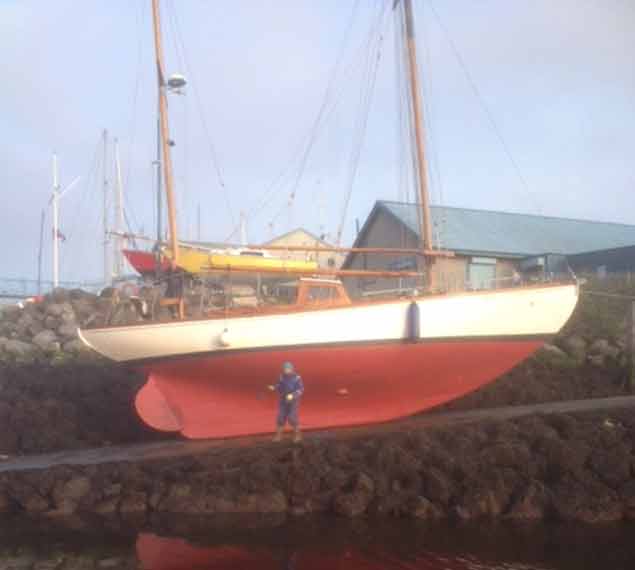 Race preparation. Maybird gets completely re-antifouled and with a fresh boot-top a fortnight ago, all in one tide at Poolbeg
Race preparation. Maybird gets completely re-antifouled and with a fresh boot-top a fortnight ago, all in one tide at Poolbeg
INSS J109 Available for Dun Laoghaire Regatta Charter
The Irish National Sailing School J109 yacht is available to charter for Volvo Dun Laoghaire regatta and other Irish sailing events this season.
Jedi is a highly competitive J109 yacht and part of DBSC's ultra–competitive Class One fleet of 20 boats on Dublin Bay.
Regular readers of Afloat.ie will know the J109 class in Ireland needs no introduction, the cruiser racer offers exciting and exhilarating sailing yet in a very user friendly and comfortable package.
Jedi is, according to the INSS's Kenny Rumball, 'a perfect example of the J109 having undergone an extensive refit over the winter of 2016-2017 to make her possibly the most IRC optimized J109 available in Europe'
Download the INSS spec sheet below
Ongoing technical issues with the Volvo Dun Laoghaire Regatta website this week is giving sailors an extra opportunity to avail of a discounted early bird entry fee that was due to close today.
Organisers issued an apology via social media this morning adding two weeks to the entry deadline. VDLR say: 'Apologies for the chronic website problems this week - because of this we're EXTENDING the #EarlyBird entry deadline to 13th April'.
In the meantime, while the issues with the site are resolved, an entry list at March 20 is here. And the latest Dun Laoghaire Regatta news is on our dedicated section on Afloat.ie here
ISORA Adds ECHO Handicap for 2017, UK Offshore Boats Encouraged to Register For Special €10 rate
The Irish Sea Offshore Racing Association (ISORA) will trial the Irish based “Progressive ECHO” rating in all its races this season.
ISORA Chief Peter Ryan says the performance based rating will 'produce a greater spread in the results and prizes.
Most racing boats in Ireland have an ECHO rating issued with their IRC Rating for the Irish Sailing Association (ISA) but as part of the new move by the Irish–UK offshore body, UK boats are being encouraged to take part in the ECHO rating, ISORA have negotiated an initial fee for the ECHO rating of €10 for those UK boats competing in ISORA.
Over the winter, ICRA rating guru Denis Kiely re-ran all last season’s results under the ECHO rating to ensure that those boats who have not used ECHO in the past will have their appropriate performance handicap for the first race, based on their last year’s ISORA performance.
Applications for the ECHO rating should be made through ISORA.
Howth Yacht Club's Conor Fogerty Prepares For Ostar Race 2017
This month sees Conor Fogerty of Howth Yacht Club, preparing for one of the most prestigious and demanding solo ocean races in the international yachting calendar.
The latest instalment of the OSTAR (Original Solo Transatlantic Race), commences on 29th May 2017.
This will see Fogerty, bring his much loved and widely campaigned Sunfast 3600 'Bam', to the start line off Plymouth Sound in the English Channel. This gruelling race which is taxing on both body and mind, heads across the North Atlantic Ocean, to Newport Rhode Island, over 3,000 miles of Ocean.
Although the race name OSTAR may trip easily off the tongue, this generally upwind race, is not for the faint hearted or indeed occasional offshore adventurer.
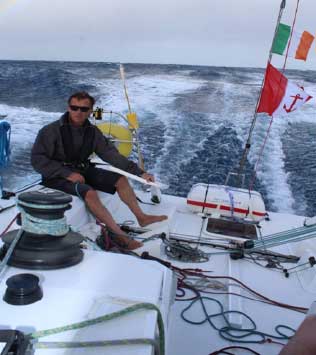 Fogerty and Bam surfing at 20–knots during a 2016 transatlantic crossing
Fogerty and Bam surfing at 20–knots during a 2016 transatlantic crossing
The event sees the solo skippers pit themselves against strong gales and big seas as a matter of course, not to mention, ice, fog, shipping and the occasional whale attack is not unknown.
He will follow in the footsteps of a veritable who’s who of sailing greats and pioneers of ocean racing. The names of Chichester, Knox Johnson, Blyth, Tabarly, Peyron, not forgetting Ellen McArthur are some of those who have sailed this great race before him.
In an Irish context, solo sailor Barry Hurley of the Royal Irish Yacht Club took a class win in the 2009 Ostar after a 21–day match race with an Italian competitor.
OSTAR history can be traced to an English war veteran Blondie Hassler who set about organising the race in 1956 and saw it first run in 1960 under the guidance of The Royal Western Yacht Club. From those early days of sextants and hand bearing compasses, the race has witnessed the trialling of most major innovations in boat design and on board equipment common in modern day sailing. This includes the advent of multi hulls, autopilots, water ballast, GPS, and weather routing. Whilst all of the above have certainly revolutionised sailing for the modern day solo adventurer, they do little to diminish the stark reality of dealing with the conditions, the low pressure systems of the North Atlantic create.
 After 21 days at sea Barry Hurley makes a dawn finish and a class win in the 2009 Ostar
After 21 days at sea Barry Hurley makes a dawn finish and a class win in the 2009 Ostar
Conor is a seasoned campaigner. Last year alone saw his 11–metre Bam start the year with a win in the RORC Caribbean 600. From there a 16–day solo trip to the Azores and then after some much needed R &R in Horta, back to Ireland.
Next up were the ISORA races across the Irish Sea and forays to the South Coast of England and North of France competing in RORC races. Not forgetting a 3rd place finish in the Round Ireland and a Solo Fastnet (SORC) challenge, which but for a fickle wind at the end line, would have seen him claim the top of the podium. The season came down with the Middle Sea Race off Malta which saw Fogerty and Bam claim the 3rd overall in class for the RORC 2016 season.
This was a fitting reward for skipper and crew for the thousands of hard miles campaigning in 2016, without the big budgets of some competitors or indeed sponsorship.
It has been said that the major achievement racing the OSTAR is to get the boat to the start line.
These campaigns do not come easily or cheaply to the racing privateer. The aim now is to get as many sponsors as possible on board, to back this commendable Corinthian challenge.
Conor is in discussions with potential sponsors at the moment, but he also provides a grass route sponsorship option for an individual to have their name displayed on the hull to show support, and to give his attempt every chance of success, and to fly the Irish flag with distinction. If you are interested in providing support, please contact [email protected]
The Irish Sea Offshore Racing body ISORA has announced Global Displays Ltd as a sponsor of the Welsh Coastal Series, part of the ISORA overall series in 2017
Global Display have provided ISORA with an additional 10 Yellow Brick trackers to enable races on both sides of the Irish Sea to benefit from competitors using YB. This is great news for both competitors and shore based supporters, says ISORA's Peter Ryan but crucially enables the ISORA race management committee to set courses using virtual waypoints and remote finish/start lines.
Richard Cook, an experienced offshore sailor and managing director of Global Displays ommented "Global Displays is delighted to be associated with ISORA and its use of YB trackers for innovative race management"
ISORA's Peter Ryan anticipates a 50% increase in offshore sailors into next July's Volvo Dun Laoghaire Regatta. The buoyant prediction is in step with an encouraging ' Super Early Bird' entry for the biennial event that closed on New Year's Eve. Organisers received a fantastic response to the new Super Early Bird Entry draw with 178 fully paid entries received. The current entry now stands at 184 boats.
Entries have alrady been received from 31 of the 33 Regatta classes with great support from all the class captains who encouraged early entry within their fleets.
Fleets which currently have already over 10 boats entered (with still six months to close of entry) are Sigma 33, IRC Offshore, Non Spinnaker, IRC Cruisers, GP14 and IDRA 14 Classes.
An independently & professionally audited draw took place in the National Yacht Club on Monday 9th of January and 18 winners were selected across a number of classes and yacht clubs in IRL and UK (list of winners attached). These winners will have their entry fee fully refunded to them by the organisers.
A discounted 'Early Bird Entry' is open till 31st March 2017.
ISORA Race Schedule For 2017 Now Available
#ISORA - The draft ISORA race schedule for 2017 is now available online.
The new season kicks off with two races on Saturday 22 April, the ISORA/RAYC Dun Laoghaire to Wicklow coastal race, and the Pwllheli Castle Race on the other side of the Irish Sea in Wales.
That’s followed by the first offshore race on Saturday 13 May from Holyhead to Dun Laoghaire.
The highlight of the schedule as always is the 270-mile Dun Laoghaire to Dingle offshore race, set for Wednesday 14 June.
And almost five months of racing is set to conclude on Saturday 9 September with the Pwllheli to Dun Laoghaire offshore run.
The Notice of Race is has also been published, available to download with the 2017 race schedule below.
It’s indicative of the pace of Irish sailing in 2016 that for anyone taking an overview, it takes a bit of an effort to remember what the weather was like for much of our spring, summer and autumn. Admittedly, here in Afloat.ie we may skew recollections, as we’ll always go for a sunny photo or video if at all possible. Yet the cascade of memories of success and memorable events at home and abroad has been at such a pace that even if the sun wasn’t shining or the wind wasn’t obliging, the recollections are good. W M Nixon tries to make sense of the highlights.
If 2016 wasn’t the greatest Irish sailing season ever, then we’ll be happy to take on board proposals arguing the case for other years. And in the fantastic golden year of 2016, the supreme moment was on the evening of Tuesday August 16th, when the entire nation at home – or at least the entire sailing nation – was glued to a television screen of one sort or another, following every twist and turn for Annalise Murphy in the brief but intense drama of the final Olympic Medal Race for the Women’s Laser Radials on the flukey yet undeniably glamorous waters off Rio de Janeiro.
As the weeks and months have passed since, we’ve forgotten that for Annalise to win the Silver Medal, it was a pilgrimage of sorts to put right the pain of missing out so closely on a medal at the 2012 Olympics. We’ve also forgotten that the tension was exacerbated by the fact that the Medals Race should have been held on Monday August 15th, but was blown out to cause an agonizing 24-hour postponement. And we’ve largely forgotten that only three months earlier, the prospects hadn’t seemed at all good for Ireland’s best hope, with a poor performance at the Worlds in Mexico.
Yet we remember just enough of that situation to put into perspective the ten weeks transformation that Annalise wrought within herself. With her dedicated support team, she ensured that she’d become a hugely improved sailor, a fitter athlete and psychologically in a very good place, as she took on the Olympic challenge on August 8th with a cool confidence which in due course received its proper reward.
Thanks to the close focus which was put on the outstanding Murphy medal, we are well aware of the breadth and depth of the backup team which helped to make it all possible. But in the end it was just one lone sailor entirely on her own who was trying to carve out the right route through extraordinarily difficult sailing conditions, racing against the very best in the world. So it is entirely right and proper that Irish sailing will remember 2016 primarily as the year of Annalise’s Silver Medal.
With a peak like this, a manageable review of the season can only re-visit the highlights, so if your favourite event doesn’t come up in the next thousand or so words, that’s the way it when the Olympics come up, which mercifully is only once every four years.
A year hence, we’ll be looking back at a more normal season in all its variety, but for now some further thoughts on the Rio experience fit the bill. For the fact is, the entire Irish sailing team put in a decent showing. Best of the rest of them were Ryan Seaton and Matt McGovern in the 49er. Had the chips fallen slightly differently, they might have come home with a medal themselves. But as it is, the fact that they had two race wins would have been a matter of added excitement in any previous year.
 Ryan Seaton & Matt McGovern in the 49er recorded two race wins in the Rio Olympics
Ryan Seaton & Matt McGovern in the 49er recorded two race wins in the Rio Olympics
As for Andrea Brewster and Saskia Tidey in the 49er FX, they had one of their best regattas, very much at the races for most of the time, while the very young Finn Lynch – youngest sailor racing the Olympics – may not have been on his best form in the Laser Men’s, but his snatching of the Irish place in this class as late as May 18th in Mexico was testament to his grit, as he still hadn’t fully recovered from an injury sustained in an accident while out on some training cycling.
In fact, if there’s one little lesson which really came home from Rio, it’s the need to keep your athletes in one piece all year round. Our young international-level sailors can be an exuberant bunch, sometimes training and post-event relaxation becomes horseplay, and it was notable that some significant longterm campaigns were knocked off course by silly injuries.
Thus in looking back at the way Annalise’s success was celebrated in the heart-warming welcome home party at the national Yacht Club on Thursday August 26th, a notable recollection is that in thanking all those who had helped her to the Medal, Annalise particularly mentioned the physiotherapist Mark McCabe. For it seems that whatever training and guidance Mark McCabe has been giving her over the years, she has never been hampered by any serious injury or temporary disability.
This may seem a slightly odd point to be making in an annual sailing review, but there’s a lesson for sailors at every level in this. So if 2016 also emerges as the year in which we all learned the benefits of keeping ourselves in good shape and following best practice in sailing fitness, then it will have been be a very good year indeed.
But as the Olympics didn’t take over the stage until the second week in August, an impressive amount of sailing had already been registered. Indeed, it went right back to January when Doug Elmes and Colin O’Sullivan – who sail from Howth but Doug’s from Kilkenny and Colin is from Malahide – returned from Malaysia with the Bronze Medal from the 420 Worlds.
 A Bronze Medal for Ireland with Doug Elmes and Colin O’Sullivan in the 420 Worlds in Malaysia
A Bronze Medal for Ireland with Doug Elmes and Colin O’Sullivan in the 420 Worlds in Malaysia
Then in February offshore racing came centre stage with the RORC Caribbean 600 seeing Conor Fogerty of Howth with his Sunfast 3600 Bam! continuing a remarkable programme of Transoceanic criss-crossing (some of it single-handed), the Caribbean 600 “diversion” producing a win in Class 3.
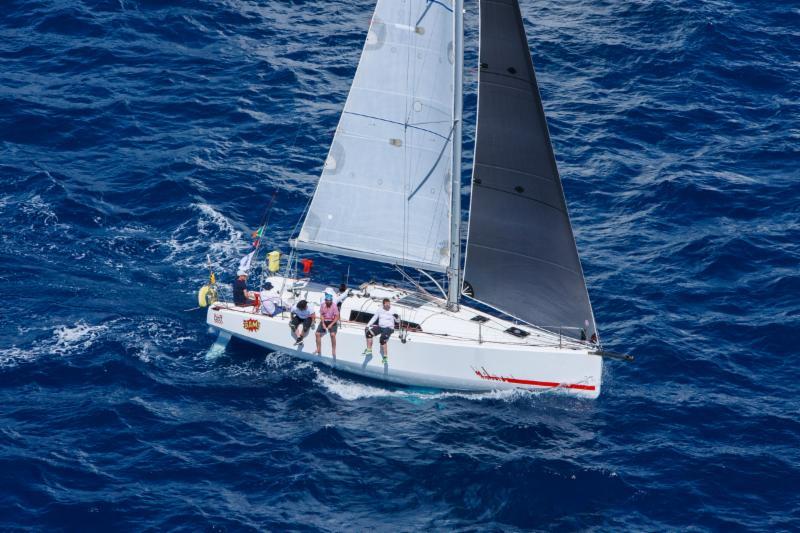 Conor Fogerty’s Bam! on the way to the class win in the RORC Caribbean 600 Race
Conor Fogerty’s Bam! on the way to the class win in the RORC Caribbean 600 Race
Into April, and attention focused on the Irish GP 14 Association’s superb group effort in getting 22 boats to Barbados for the GP14 Worlds 2016. Merely to achieve that was quite something in itself, but then Shane McCarthy of Greystones, crewed by Andy Davis, emerged as the new World Champion. That provided extra impetus back home as the rapidly developing Greystones Sailing Club worked towards its new clubhouse, which came on stream in May with the hosting of the Cruising Association of Ireland’s Start-of-Season rally.
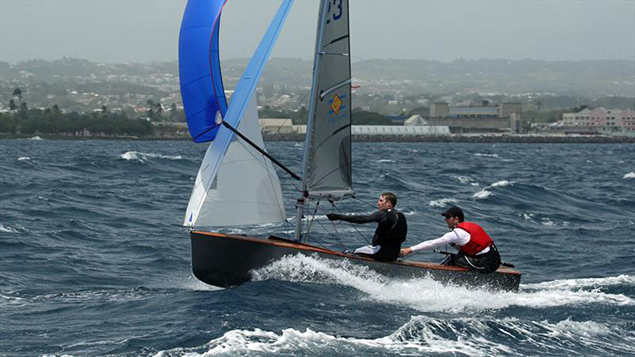 Shane McCarthy of Greystones wins the GP14Worlds in Barbados
Shane McCarthy of Greystones wins the GP14Worlds in Barbados
With the proper season in Ireland under way, June’s highlight was clearly the Volvo Round Ireland race from Wicklow, but before that ICRA had to get in their three-day Nationals at Howth, and despite light winds the programme was completed, winners including John Maybury’s J/109 Joker II in Division 1, Dave Cullen’s Half Tonner Checkmate XV in Div. 2, Ken Lawless and Siobhan McCormack’s Quarter Tonner Cartoon in Division 3, and Colm Bermingham’s Elan 333 Bite the Bullet in Division 4.
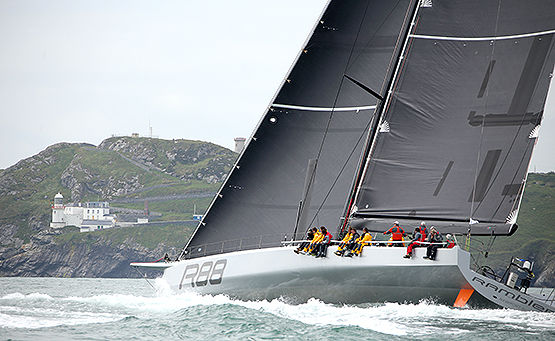 With a hugely talented crew, George David’s Rambler 88 dominated the mono hull classes in the Volvo Round Ireland race
With a hugely talented crew, George David’s Rambler 88 dominated the mono hull classes in the Volvo Round Ireland race
In the Volvo Round Ireland Race starting June 18th, for the leaders at any rate lack of wind was definitely not a problem. For those biggies, it was a cracker. And as an event, the Round Ireland is back and then some, with 63 entries including George David’s wonderful Rambler 88 and three MODs which sailed the entire course within close sight of each other, and records tumbling at every turn.
Rambler had a brilliant a crew of international talents, and they were able to take every last advantage of the fact that the weather Gods – or more properly the wind Gods – smiled on them. They took monohull line honours in a runaway record time, and then achieved what many would have thought almost impossible for a boat with a stratospheric rating - they won overall on IRC as well.
As for the MOD 70s, with Damian Foxall with Sidney Gavignet on record holder Oman Sailing, and Justin Slattery with Lloyd Thornburg on Phaedo III, there was added home interest, particularly as both Irish stars admitted they’d been so busy all over the world building their sailing careers that they were Round Ireland virgins……
And what a race the trio of trimarans served up for those virgins…... Within reach of the finish in the dark, Team Concise was in the lead in a fading breeze, but Oman Sailing went a little bit offshore and found a fresher air to come in on port tack at first light and nip into the win.
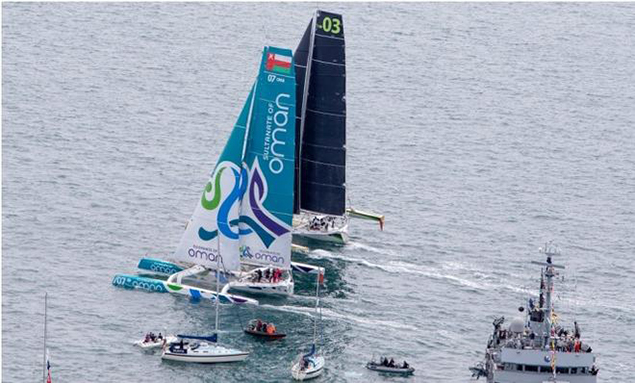 Oman Sailing and Phaedo 3 at the start of the Volvo Round Ireland Race. Oman snatched the multi-hull lead in the final mile of the race to win and overturn the record she already held.
Oman Sailing and Phaedo 3 at the start of the Volvo Round Ireland Race. Oman snatched the multi-hull lead in the final mile of the race to win and overturn the record she already held.
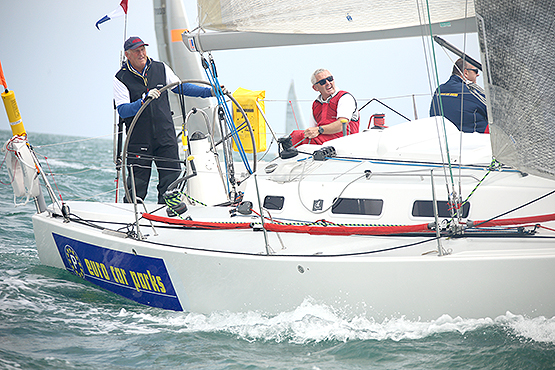 The J/109 Euro Car parks (Dave Cullen), seen here with Mark Mansfield on the helm shortly after the start, was the only Irish boat to take a class win in the Volvo Round Ireland race
The J/109 Euro Car parks (Dave Cullen), seen here with Mark Mansfield on the helm shortly after the start, was the only Irish boat to take a class win in the Volvo Round Ireland race
As for any all-Irish contenders, the best performance was put in by the J/109 Euro Car Parks (Dave Cullen), the only Irish class winner, a good marker early in the season, for at the beginning of October the temporary Euro Car parks, long since reverted to her proper name of Storm, won the Irish J/109 Nationals for Pat Kelly and his keen crew from Rush Sailing Club.
July had three major highlights – Volvo Cork Week at Crosshaven, the Topper Worlds at Ballyholme, and the KBC Laser Radial Worlds at Dun Laoghaire. While the numbers involved in the two dinghy events were stupendous, it was Volvo Cork Week which captured public imagination in an unexpected way with the inaugural Beaufort Cup series.
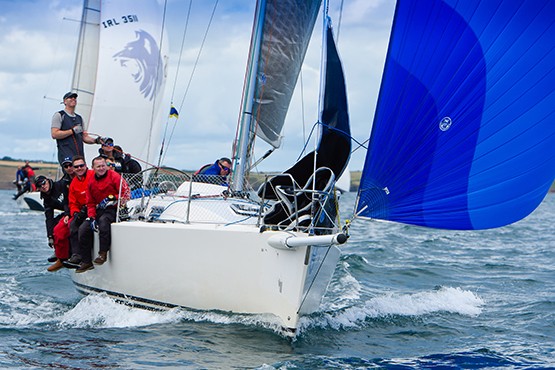 Joker II, skippered by Commandant Barry Byrne, became the first winner of the Beaufort Cup.
Joker II, skippered by Commandant Barry Byrne, became the first winner of the Beaufort Cup.
Racing for the trophy named after the famous Irish admiral and maritime researcher, the Beaufort Cup started out to be an event with an international flavour between crews from national defence forces. But then its remit was broadened to include personnel from emergency and security services with maritime links, and in the end 32 owners generously made their boat available for something which perfectly captured the mood of the moment. The amount of goodwill generated was beyond measure, and the win by an Irish Defence Forces crew skippered by Commandant Barry Byrne sailing John Maybury’s J/109 Joker II has given a visionary event an excellent inauguration.
The Topper Worlds at Ballyholme looked like providing an Irish win until the last day, when a fresh northerly swept in with real Belfast Lough vigour to make it a big boys’ game, but young Michael Carroll from Cork hung in gamely and finished fourth overall, while Sophie Crosbie from Crosshaven was first girl and 7th overall.
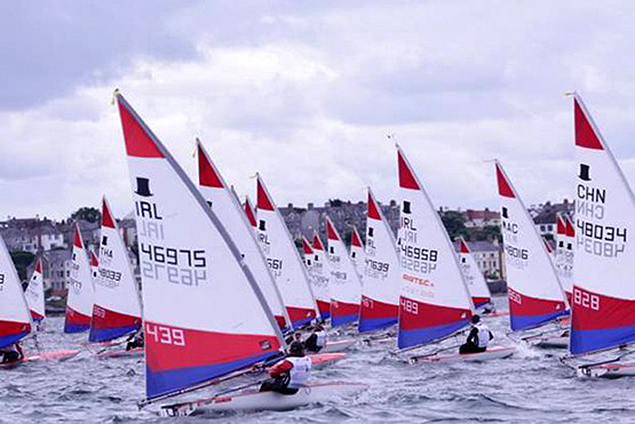 The Topper Worlds at Ballyholme had one of its most international fleets yet, including a large Irish contingent and a group from China.
The Topper Worlds at Ballyholme had one of its most international fleets yet, including a large Irish contingent and a group from China.
With a total fleet pushing towards the 350 mark, the KBC Laser Radial Worlds in Dun Laoghaire were almost beyond comprehension, but a pattern was discernible, and what was most encouraging was that at least five young Irish sailors were serious contenders at the very top level.
However, one was head and shoulders above the rest in every way, and this was Ewan MacMahon of Howth. He was right in there pitching for the Gold in some ferocious racing, and though he concluded the series with the Silver Medal, this was serious stuff and the world quite rightly sat up and took notice of a remarkable and developing talent.
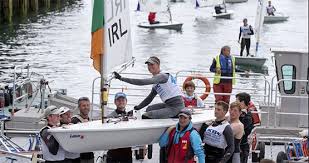 Ewan MacMahon borne ashore after winning the Silver Medal in the KBC Laser Radial Worlds in Dun Laoghaire.
Ewan MacMahon borne ashore after winning the Silver Medal in the KBC Laser Radial Worlds in Dun Laoghaire.
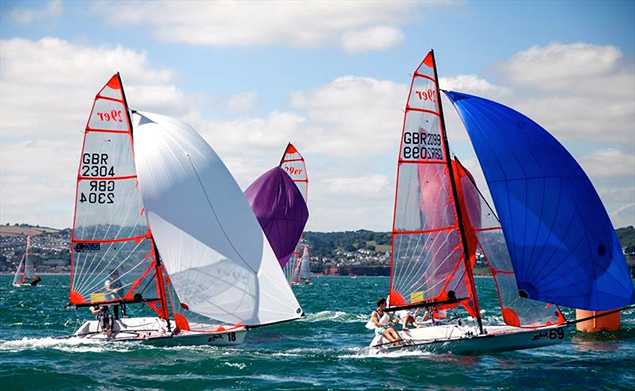 The fleet of 76 boats in the 29er British Championship at Torbay saw the win going to Harry Durcan and Harry Whittaker of Cork.
The fleet of 76 boats in the 29er British Championship at Torbay saw the win going to Harry Durcan and Harry Whittaker of Cork.
Came August, and just two days before the Olympics took all attention, 29ers took to the seas off Torbay in Devon for the annual British Championship, 76 boats in all and just one of them Irish – Harry Durcan and Harry Whittaker of Royal Cork. They won overall by two good clear points, an achievement so brilliant that further comment is superfluous.
Then in August we had of course all sorts of local festivals such as Calves Week out of Schull, but everyone’s thoughts were on the Olympics, with normality only returning after an afternoon and night of celebration seemed to have just about the entire Irish sailing community – and many non-sailors too - gathered in Dun Laoghaire and around the National Yacht Club to welcome home Annalise and her medal.
Cruising being something undertaken at its own pace, reviews of what has been achieved are a matter for more leisurely contemplation in the depths of winter. But in late August a real text-book cruise drew to its close when Neil Hegarty of Cork sailed his Dufour 34 Shelduck into Baltimore after an efficient Atlantic crossing from Newfoundland, with Shelduck blithely coping with two mid-Atlantic gales, one of Force 8 and the other hitting Force 9. There have of course been many other Atlantic crossings during 2016 involving Irish boats, but this successful conclusion of a detailed Atlantic circuit cruise of several years duration really was a model of its kind, a cruise to be savoured.
 Neil Hegarty’s Dufour 34 Shelduck during her Atlantic Circuit cruise
Neil Hegarty’s Dufour 34 Shelduck during her Atlantic Circuit cruise
Other cruises and new additions to the fleet were to be savoured as the Cruising Association of Ireland held its end-of-season rally in Dublin’s River Liffey in mid-September, with a goodly fleet providing the annual entertainment of all the opening bridges being opened at the same time in a neatly choreographed exercise, which succeeded brilliantly in bringing a sense of the sea into the heart of the city.
 “A sense of the sea into the heart of the city” – the Cruising Association of Ireland hold their Three Bridges Rally in Dublin’s River Liffey.
“A sense of the sea into the heart of the city” – the Cruising Association of Ireland hold their Three Bridges Rally in Dublin’s River Liffey.
Meanwhile in nearby Clontarf the 70th Anniversary of the iconic Irish Dinghy Racing Association 14ft OD Dinghy was celebrated in style with a series of well-attended events driven on by the energy and enthusiasm of Ian Sargent, who saw his efforts well rewarded with a memorable Gala Dinner for the class in Dun Laoghaire at the Royal St George Yacht Club, where the concept of the IDRA 14 was first aired way back in 1946.
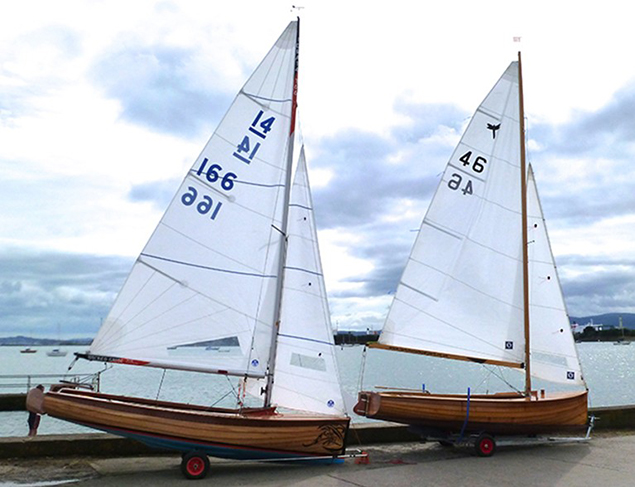 Living history. The newest IDRA 14 no. 166 (left) built 2016, and the newest Dragonfly sister-ship from Waldringfield in England, also built 2016, were the stars of the show at the IDRA 14th 70th Anniversary Regatta at Clontarf
Living history. The newest IDRA 14 no. 166 (left) built 2016, and the newest Dragonfly sister-ship from Waldringfield in England, also built 2016, were the stars of the show at the IDRA 14th 70th Anniversary Regatta at Clontarf
As for those who like it offshore with a bit of competition, 2016 was a year of further growth for the Irish Sea Offshore Racing Association, with the season neatly rounded out by a points championship settled in the final race, the overall win going to Stephen Tudor’s J/109 Sgrech from Pwllhei.
The further we got into the Autumn, the better the weather became. So although the All-Ireland Junior Championship at Schull at the end of September raced in the Dave Harte-developed TR 3.6 dinghies was put through successfully despite some very mixed weather in the rest of the country, with Johnny Durcan of Royal Cork the new champion, a week later in the first weekend of October the All-Ireland Seniors were sailed at Crosshaven with racing in the new Phil Morrison-designed Ultra variant of the National 18, and they had weather that was almost too summery on the second day.
 Johnny Durcan (Royal Cork) became the new All-Ireland Junior Champion at Schull at the end of September.
Johnny Durcan (Royal Cork) became the new All-Ireland Junior Champion at Schull at the end of September.
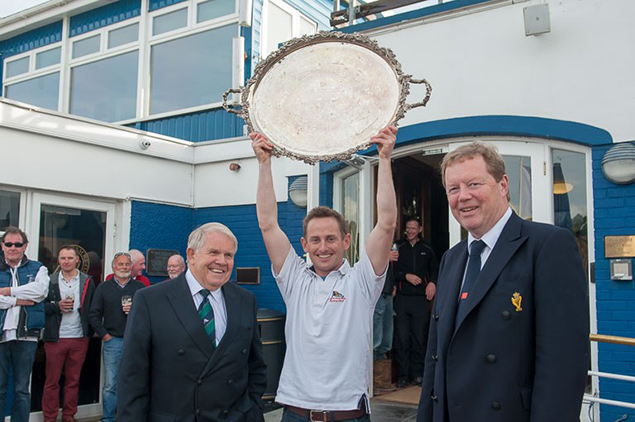 The historic salver – 2016 All-Ireland Champion Alex Barry with ISA President David Lovegrove (left) and Royal Cork YC Admiral John Roche. The annual championship for the salver will be celebrating its 70th anniversary next year.
The historic salver – 2016 All-Ireland Champion Alex Barry with ISA President David Lovegrove (left) and Royal Cork YC Admiral John Roche. The annual championship for the salver will be celebrating its 70th anniversary next year.
But a breeze filled in and it ended up as an absolute cliffhanger, with so many boats tied on points at the end that they’d to go through several permutations of countback to get a result, with RS 400 champion Alex Barry of Royal Cork and Monkstown Bay the Champion of Champions 2016.
October saw Irish interest swing towards the Mediterranean and the annual Rolex Middle Sea Race from Malta with extra Irish interest in three boats in the 107-strong fleet. Conor Fogerty’s ubiquitous Bam! appeared yet again, and though it wasn’t her most successful race, the points accumulated shunted her up to 3rd overall in the RORC Class 3 Points Championship 2016 despite doing only five RORC races, but the Caribbean 600, the Volvo Round Ireland, and the Rolex Middle Sea race all carry extra points weighting.
A better Middle Sea result was obtained by the XP 44 Xp-Act, which came second in Class 4 with her crew including the RIYC’s Barry Hurley and the Irish National Sailing School’s Kenneth Rumball. But our outstanding result was the clear overall win taken by Vincenzo Onorato’s Cookson 50 Mascalzone Latino, navigated with pure genius by international star Ian Moore, who hails from Carrickfergus.
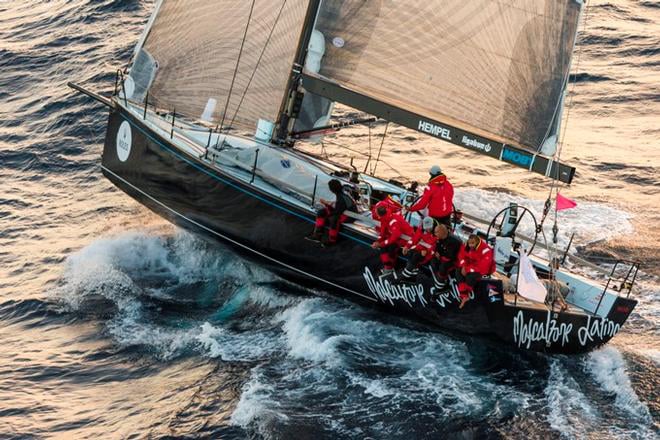 Yet another major win for Ian Moore – and yet another major win for a Cookson 50. Mascalzone Latino on her way to overall victory in the Rolex Middle Sea Race 2016. Photo Rolex
Yet another major win for Ian Moore – and yet another major win for a Cookson 50. Mascalzone Latino on her way to overall victory in the Rolex Middle Sea Race 2016. Photo Rolex
This rounded out a remarkable year for the Moore family, as his mother Wendy was Commodore 2016 in Carrickfergus Sailing Clyb, where they were celebrating their 150th Anniversary (as was the Royal Ulster YC across Belfast Lough in Bangor) with events at Carrickfergus including a Hilditch Regatta for boats constructed by the legendary Carrickfergus boatbuilder. He created many vessels of distinction including the 1898 Howth 17s, who in turn arrived in Carrick to help celebrate a year which was to finish in such style in Malta.
Except it hasn’t quite finished yet. Even as we write this. Cork Institute of Technology are in the top three in the 36th Student Yachting World Cup which concludes today in Las Rochelle. And then tomorrow the irrepressible Enda O’Coineen with Kilcullen Voyager will be one of 29 starters along the French Biscay coast off Les Sables d’Olonne, where the Vendee Globe gets under way before a crowd of tens of thousands. Irish sailing in 2016 is truly a complex and endless tapestry………

Good News For ISORA Chiefs As More Than Half Of Survey Respondents Are Regular Offshore Racers
#ISORA - More than half of respondents to the recent Irish Sea Offshore Racing Association (ISORA) fleet survey consider themselves regular offshore racers.
The online questionnaire, as previously reported on Afloat.ie, aimed to determine whether ISORA is 'providing the racing that will inspire and excite existing and future sailors', as well as solicit suggestions for possible changes and improvements.
In terms of activity, the survey was good news for ISORA chiefs.
Of the 115 completed responses, 53% considered themselves to be regular offshore racers and 30% to be regular coastal racers.
Indeed, more than three-quarters - 77% of the total - claimed to have raced in 2016.
Some 40% of responses came from self-professed owner/skippers, while 57% were crew. Almost two-thirds of respondents have been taking part in ISORA races for between one and five years, while 16% have been racing with ISORA for 10 years or more.
However, ISORA was disappointed to find that only 2% of responses came from shore crew or supporters, indicating room to grow those aspects of the association's running of events.
"it is apparent from the results that more work is required to bring crews and skippers together," the survey report states.
The survey confirmed Dun Laoghaire's dominance as the hub for the ISORA fleet, with 89% confirming that the port is accessible for boats and crews, and 86% satisfied or very satisfied with the social and racing aspects of the port.
A clear coastal axis from Howth to Greystones was revealed, as well as an east-west axis to Holyhead (66% for accessibility and 48% for social and sailing) and Pwllheli (46% and 53% respectively). Douglas on the Isle of Man scored 29% for accessibility and 50% for social.
ISORA also identified that boats based to the north of the east-west axis wish to race further north, while those to the south of the axis wish to race further south.
Responses from those who have stopped racing or competing regularly with ISORA were low, but added to an emerging pattern of changing work or family circumstances, as well as a lack of challenge from the race schedule in some cases.
Still, most replies cites the 'camaraderie, challenge and fun' as their biggest 'likes' of their experience with the association.
The full survey report is available to download below.



























